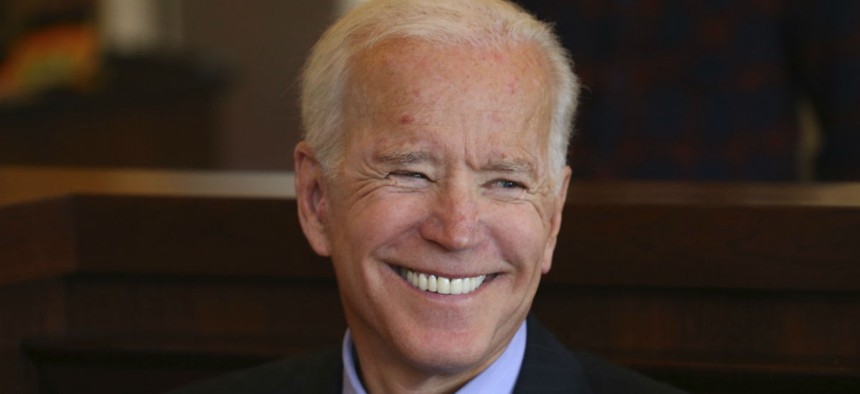What Biden's 'Campaign to Cut Waste' Says About How He Would Manage Government
The former vice president has called for a "new culture of efficiency" at federal agencies.
In 2011, President Obama signed an executive order to create a “Campaign to Cut Waste” he said would “hunt down misspent tax dollars in every agency and department of this government.” The president said he immediately knew the right person to lead the initiative.
“I know Joe is the right man to lead it because nobody messes with Joe,” Obama said of his vice president.
Joe Biden on Thursday announced his candidacy for president in a video message that focused on the ideals and promises of the country. An examination of his Campaign to Cut Waste offers a more insightful look at how he might manage the federal bureaucracy.
At a Cabinet meeting called a few months after Obama signed the executive order to demonstrate the progress of the campaign, Biden said he was personally invested in the outcome of his initiative. Obama tapped Biden for the project after the vice president led the oversight of the 2009 American Recovery and Reinvestment Act, also known as the economic stimulus package. Biden won plaudits for that effort’s transparency and limited reports of wasteful spending. During that process, he said, he learned the key to managing federal spending oversight.
“Guess what? We learned that all of you, all the Cabinet secretaries, unless you’re engaged, I’m engaged, we are each specifically held responsible, it just doesn’t get done,” he said.
The Obama administration ultimately claimed several successes as a result of the campaign at both the agency and governmentwide level. Biden pointed to an effort at the Treasury Department to suspend the minting of presidential coins in which the public was not interested, which he said would save $50 million annually. He noted the Health and Human Services Department’s inspector general teamed up with the FBI to create “strike forces” for detecting Medicare fraud. The administration also highlighted efforts to sell off excess federal property, use new tools for reducing improper payments and slash spending on government travel by $2 billion over two years.
Just six months after Obama tasked Biden to lead the effort, the Office of Management and Budget claimed $17.6 billion in savings directly stemming from the campaign.
"When the president and I launched the Campaign to Cut Waste, we knew success would be measured by results, not rhetoric," Biden said at the time. "The sharp reduction in payment errors announced today demonstrates this administration is serious about cutting waste."
Biden said the campaign would not just save money, but restore Americans’ trust in their government.
“This effort involves a lot more than just eliminating waste and fraud,” Biden said. “It means instilling a new culture of efficiency in each of our agencies, greater responsibility, responsiveness and accountability.” He added the administration was “intent on changing the way the government does business.”
At a December 2011 meeting, Biden noted that Obama had tasked agencies with cutting 20 percent of their travel, printing and administrative expenses, asking leadership to report back with specific measures taken at a meeting scheduled a few months later. No public record of such a meeting exists. The administration also faced criticism for simply repeating the efforts spearheaded by most recent presidents.
Prior to the waste-cutting initiative, Biden led the federal government's implementation of the stimulus package. He brought on Ed DeSeve as a special adviser for the recovery effort, who told Government Executive that Biden took his role "extremely seriously."
"Joe was the heart and soul of the whole operation," said DeSeve, who noted he was retired from public service and would have no interest in serving in a Biden administration.
DeSeve said Biden was "right on top of things" with regard to the Recovery Act, explaining the vice president talked frequently of maintaining a "well-lit house" that people would not steal from. He added that Biden would personally call deputy secretaries at agencies to follow up on oversight initiatives and criticize those he felt were falling short. DeSeve said the keys to the program's success were the constant financial reports, the creation of a network of people responsible for answering questions based on spending in a certain region or at a specific agency, and the transparency made possible through Recovery.gov.
"Attention from the top was critical," said DeSeve, who predicted Biden would draw from those experiences if he were to become head of the executive branch.
Biden also offered a look into his priorities on management of and spending at federal agencies during his last campaign for president. During his 2008 run, Biden vowed to support a “common-sense budget and responsible spending” by adopting a pay-as-you-go rule that would require offsetting all new federal appropriations. That would reverse the growing trend over the last several administrations that have overseen a massive increase of deficit spending. He also pledged to always support workers’ rights to collectively bargain, another reversal from the current administration’s push to chip away at federal unions’ negotiating power. Biden said he would require federal agencies to significantly increase their use of renewable energy.
The former vice president recently addressed the American Society for Public Administration to voice his support for civil servants.
“Dedicated public servants are the lifeblood of democracy,” Biden said in his address last month. “It doesn’t function without them.”
He called on the employees in the audience not to become jaded or discouraged by some of the public disparagement they face from ideological politicians looking to score political points.
“Some of you write the rules, some of you analyze the budget,” Biden said. “You’re the keepers of the faith. You’re the tenders of the flame that keeps all of us believing in American democracy.”
NEXT STORY: Trump’s Chief of Staff Is Having a Great Time








